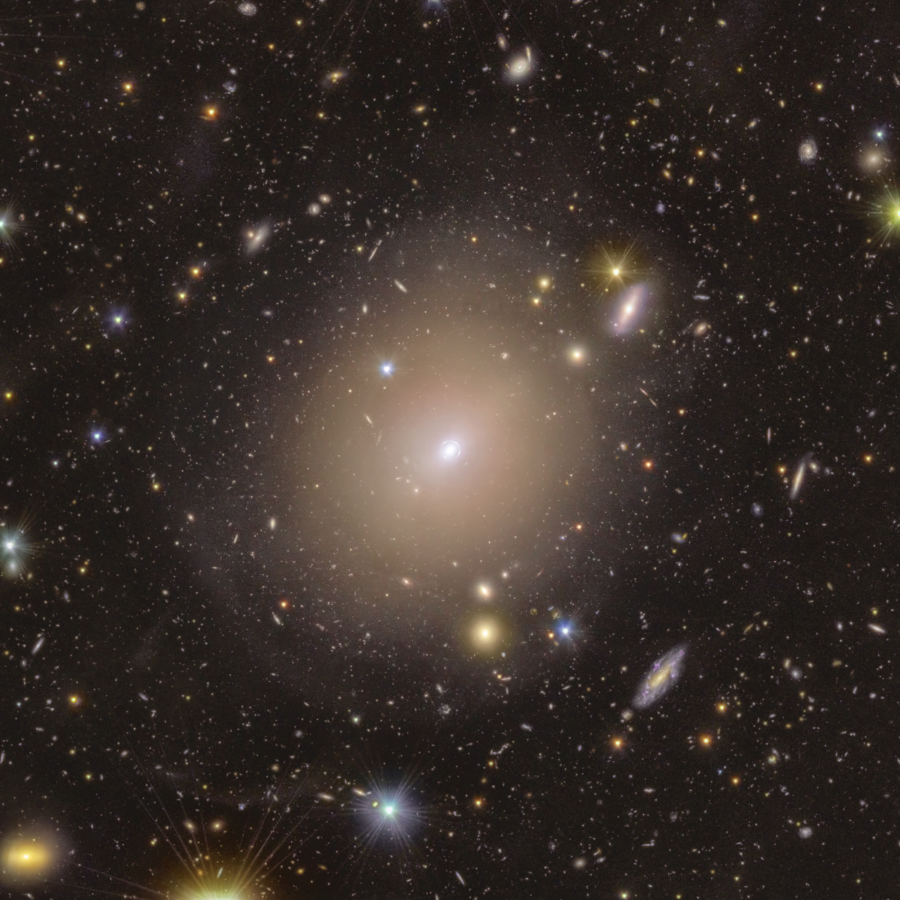OU News
News from The Open University
- Home
- Euclid mission discovers a stunning ‘Einstein ring’
Euclid mission discovers a stunning ‘Einstein ring’
Posted on • Science, maths, computing and technology

The European Space Agency’s (ESA) dark universe detective, Euclid, has discovered a stunning ‘Einstein ring’, with help from astronomy experts at The Open University (OU).
Euclid blasted off on its six-year mission to explore the dark Universe on 1 July 2023. Before the spacecraft could begin its survey, the team of scientists and engineers on Earth had to make sure everything was working properly. During this early testing phase, in September 2023, Euclid sent some images back to Earth. They were deliberately out of focus, but in one fuzzy image there was a hint of a very special occurrence.
The Einstein Ring, an extremely rare phenomenon, turned out to be hiding in plain sight in a galaxy not far away. The galaxy, called NGC 6505, is around 590 million light-years from Earth, a stone’s throw away in cosmic terms. But this is the first time that the ring of light surrounding its centre is detected, thanks to Euclid’s high-resolution instruments.
Stephen Serjeant, co-author of the research and Professor of Astronomy at the OU, commented on the discovery:
“This is a beautiful, extraordinary, thrilling and lucky find in our first data. It’s so perfect it looks almost like it’s a simulation. We get to see a background galaxy through the warped space and time in a very nearby foreground galaxy. We can use it to work out how much dark matter and how many stars there are in the centre of the foreground galaxy.”
The ring around the foreground galaxy is made up of light from a farther out bright galaxy. This background galaxy is 4.42 billion light-years away, and its light has been distorted by gravity on its way to us. The far-away galaxy hasn’t been observed before and doesn’t yet have a name.
Albert Einstein’s general theory of relativity predicts that light will bend around objects in space, so that they deflect the light like a giant lens. This gravitational lensing effect is bigger for more massive objects – galaxies and clusters of galaxies. It means we can sometimes see the light from distant galaxies that would otherwise be hidden.
If the alignment is just right, the light from the distant source galaxy bends to form a spectacular ring around the foreground object. These Einstein rings are a rich laboratory for scientists. Studying their gravitational effects can help us learn about the expansion of the Universe, detect the effects of invisible dark matter and dark energy, and investigate the background source whose light is bent by dark matter in between us and the source.
By exploring how the Universe has expanded and formed over its cosmic history, Euclid will reveal more about the role of gravity and the nature of dark energy and dark matter. The space telescope will map more than a third of the sky, observing billions of galaxies out to 10 billion light-years. It is expected to find around 100 000 strong lenses, but to find one that’s so spectacular – and so close to home – is astonishing. Until now, less than 1000 strong lenses were known, and even fewer were imaged at high resolution.
At the OU, PhD student Ruby Pearce-Casey is building on this by creating artificial intelligence to find more of these ‘beautiful warps’ in space and time.
Ruby commented:
“Searching for these warps in spacetime is a tricky needle-in-a-haystack problem. Fortunately, we have machine learning models trained on a hundred million galaxy classifications by human volunteers, which I fine-tuned to crack the problem. We still need humans to check what the machines found, but the problem of finding these rare and beautiful warps with Euclid is now tractable.”
Although this Einstein ring is stunning, Euclid’s main job is searching for the more subtle effects of weak gravitational lensing, where background galaxies appear only mildly stretched or displaced. To detect this effect, scientists will need to analyse billions of galaxies. Euclid began its detailed survey of the sky on 14 February 2024 and is gradually creating the most extensive 3D map of the Universe yet. Such an amazing find, so early in its mission, means Euclid is on course to uncover many more hidden secrets.
Header image: Euclid’s fuzzy view of galaxy NGC 6505 with an Einstein ring around its centre, embedded in its cosmic neighbourhood. Credit: ESA/Euclid/Euclid Consortium/NASA, image processing by J.-C. Cuillandre, T. Li
Euclid: A complete Einstein ring in NGC 6505 by C. M. O’Riordan et al is published today in Astronomy & Astrophysics. DOI: 10.1051/0004-6361/202453014 https://www.aanda.org/10.1051/0004-6361/202453014